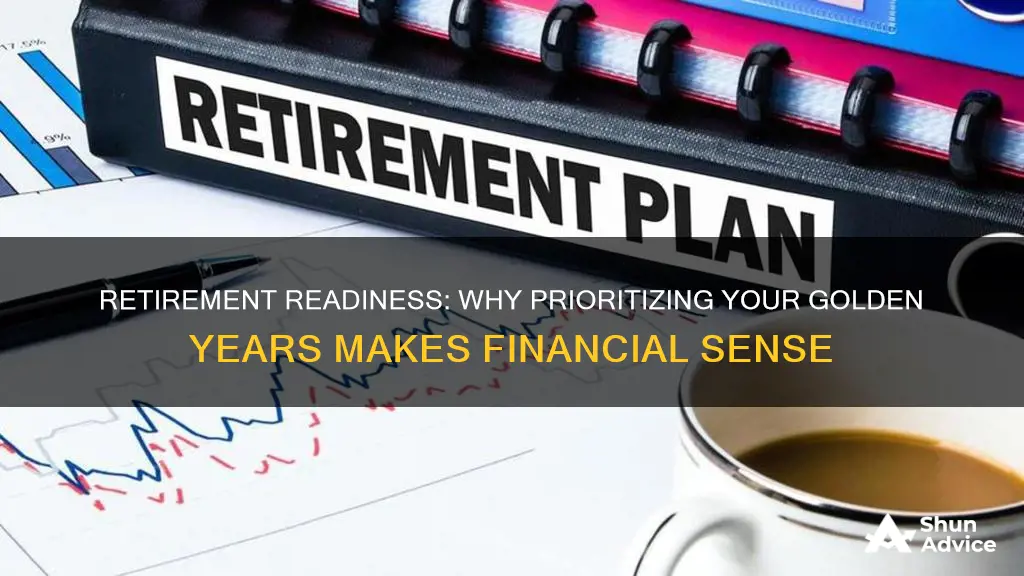
Retirement investing should be prioritised over non-retirement investing for several reasons. Firstly, retirement accounts offer tax benefits such as tax-deductible contributions and tax-deferred earnings. Secondly, employer-sponsored retirement plans often include matching contributions, providing employees with free money that can boost their retirement savings. Additionally, retirement accounts help individuals save for the long term by taking advantage of the power of compounding over several decades. Furthermore, retirement accounts provide a disciplined approach to saving, as contributions are typically automated through payroll deductions. Finally, retirement accounts ensure individuals have sufficient funds to maintain their lifestyle during retirement, as social security benefits alone may not be enough. Thus, while non-retirement investing offers benefits such as greater control and flexibility, prioritising retirement investing is crucial for a secure financial future.
| Characteristics | Values |
|---|---|
| Tax treatment | Retirement accounts are "qualified investment accounts" and receive beneficial tax treatment. Contributions are either pre-tax or tax-deductible, and earnings are tax-deferred until withdrawal. |
| Annual contribution limits | Retirement accounts have annual contribution limits and penalties for early withdrawal. |
| Employer matching | Many employers match contributions up to a certain limit. |
| Inertia | Contributions are automatically taken from your paycheck, so you don't have to think about it. |
| Control | With employer plans, you may be limited by what investments are available. A brokerage account allows you to choose your own investments. |
| Tax diversification | Non-qualified accounts allow you to be more strategic about how and when you access your money. |
| Contribution limits | There are no limits on how much money you can contribute each year to a brokerage account. |
| Tax treatment of brokerage accounts | Brokerage accounts are taxable, as they're funded with after-tax money. You'll pay taxes on dividends, interest, and capital gains. |
What You'll Learn

Prioritise paying off high-interest debt
If you're trying to decide whether to pay off debt or invest for retirement, it's important to consider which approach will provide a better return on investment (ROI). While you should always pay the minimum balance on any debts, if you pay extra beyond the required payment instead of investing that money, your ROI will be the amount of interest saved. For example, if you have credit card debt at 17% interest, your ROI will be pretty high. However, if you have low-interest mortgage debt at 3.50% and you can deduct the interest paid on your home loan when you file your taxes, then your ROI is very low.
On the other hand, if you invest your money instead of paying off debt, your ROI is the money that your investments make. You may also get a 401(k) match from your employer, which could provide as much as a 100% ROI if they match your contributions on a dollar-for-dollar basis. Additionally, you could qualify for tax breaks for retirement investing, such as deductions for contributions to a 401(k) or IRA, or the saver's credit, which could cut up to $2,000 off your tax bill.
Ultimately, the decision to prioritise paying off high-interest debt or investing for retirement depends on which option will provide a better ROI. If you can get a better ROI from paying extra towards your debt, even after considering tax savings and employer matching contributions, then it's better to focus on paying off your loans as soon as possible. However, if your ROI is better by investing, you should make minimum payments on your debt and put the rest of your money towards retirement savings.
A hybrid approach is also an option, where you put extra money into your 401(k) until you've earned the maximum employer match, and then redirect extra funds towards paying off high-interest credit card debt. Alternatively, you could work on paying off high-interest debt first and then focus on retirement savings instead of sending extra money towards a low-interest loan.
One popular strategy for tackling multiple debts is the avalanche method, which prioritises paying off debts with the highest interest rate first. This approach can save you both money and time by reducing the total amount of interest you pay over time. Another strategy is the snowball method, which focuses on paying off debts with the smallest balance first to help build motivation for borrowers with many small debts.
Retirement Planning: Navigating the Advisor Conundrum
You may want to see also

Take advantage of employer matching contributions
When it comes to retirement planning, taking advantage of employer-matching contributions is a crucial strategy. This is when your employer contributes a certain amount to your retirement savings plan, typically based on the amount of your annual contribution. Not utilising this benefit is akin to leaving free money on the table. Here's why prioritising this aspect of retirement investing is essential:
Compound Returns
Employer-matching contributions can significantly boost your retirement savings over time due to compound returns. The additional funds from your employer are invested and earn returns, generating even more returns. This compounding effect can make a noticeable difference in your retirement nest egg.
Common and Attractive Benefit
Employer-matching contributions are prevalent, with estimates suggesting that 98% of companies offering a 401(k) plan also match employee contributions in some form. This benefit is an attractive perk for employees, helping companies retain top talent and stay competitive in the job market.
Maximising Your Savings
By taking full advantage of employer-matching contributions, you can maximise your retirement savings. Contribute enough to receive the maximum matching contribution from your employer. This effectively gives you free money on top of your salary, accelerating your progress toward your retirement goals.
Vesting Schedules
It's important to understand vesting schedules, which dictate how much of your employer's matching contributions you own based on your tenure. Some employers use vesting schedules to incentivise employees to stay with the company. While it may take several years to become fully vested, it's worth staying with the company to secure these additional funds for your retirement.
Tax Benefits
Contributions to your retirement plan, including employer-matching contributions, often grow tax-free while in the plan. You only pay taxes when you withdraw the funds during retirement. This tax-deferred growth further enhances the value of employer-matching contributions, allowing your savings to compound without immediate tax erosion.
In summary, prioritising retirement investing through employer-matching contributions is a wise financial decision. It boosts your savings, leverages compound returns, and comes with potential tax benefits. By taking full advantage of this benefit, you can achieve a more secure and comfortable retirement.
Sports Fandom: Why the Obsession?
You may want to see also

Consider a Roth IRA
A Roth IRA is a type of tax-advantaged individual retirement account. The primary benefit of a Roth IRA is that your contributions and the earnings on those contributions can grow tax-free and be withdrawn tax-free after age 59½, assuming the account has been open for at least five years. In other words, you pay taxes on money going into your Roth IRA, and then all future withdrawals are tax-free.
Roth IRAs are best when you think your marginal taxes will be higher in retirement than they are right now. If you expect to be in a higher tax bracket once you retire, you may find the Roth IRA more advantageous since the total tax avoided in retirement will be greater than the income tax paid in the present. Therefore, younger and lower-income workers may benefit the most from a Roth IRA.
Additionally, you can withdraw your contributions (but not earnings) at any time, tax- and penalty-free.
However, unlike a 401(k), a Roth IRA does not include an upfront tax break. Annual contribution limits are also about a third of 401(k)s. And for some high-income individuals, contributions are either reduced or not allowed.
To open a Roth IRA, you must first decide what type of investor you are. If you're a "do-it-yourself" investor, choose a brokerage. If you're a "manage it for me" or hands-off investor, choose a robo-advisor. Next, choose how much you want to invest, gather the necessary paperwork, and pick your investments.
Investing in Educators: A Guide to Supporting Teacher Retirement
You may want to see also

Save in a taxable account
While tax-advantaged retirement accounts such as 401(k)s, IRAs, and 529s are popular investment vehicles, they come with restrictions and confusing rules regarding withdrawals. For instance, early withdrawals from 401(k)s, traditional IRAs, and 529s usually incur a 10% penalty. In contrast, taxable accounts offer greater flexibility and control over your money. Here are some reasons why you may want to consider saving in a taxable account:
- Accessibility and flexibility: Taxable accounts allow you to withdraw your money at any time, for any purpose, without penalties. This gives you the freedom to use your savings for retirement, college expenses, vacations, or any other financial goal.
- Tax minimization: While taxable accounts are subject to taxes on capital gains, you can minimize your tax liability by carefully choosing the types of assets you hold in these accounts. For example, consider investing in broad-range index exchange-traded funds (ETFs) or index mutual funds with low turnover, as these tend to trigger fewer capital gains distributions. Municipal bonds may also be a good option as their income is often exempt from federal and state taxes.
- No required minimum distributions: Unlike traditional IRAs and 401(k)s, which require you to start withdrawing money at age 72, taxable accounts have no such requirement. You can let your money grow for as long as you want without being forced to take distributions.
- Potential tax savings for heirs: In the unfortunate event of your passing, your heirs will receive the investments in your taxable account with a stepped-up basis. This means they will be taxed as if they bought the investments at their value on the day you died, potentially resulting in lower capital gains taxes.
- More control over taxes in retirement: During retirement, withdrawals from traditional IRAs and 401(k)s are considered ordinary income and may push you into a higher tax bracket. With a taxable account, you can plan your withdrawals more effectively to stay within a lower tax bracket. Additionally, if you hold your investments for more than a year, you'll typically pay the long-term capital gains rate, which is often lower than your income tax rate.
- Tax-loss harvesting: Taxable accounts allow you to offset up to $3,000 of ordinary income with investment losses each year on your tax return. This strategy can help minimize your overall tax burden.
In summary, while tax-advantaged accounts have their benefits, taxable accounts offer flexibility, control, and tax advantages that should not be overlooked. They can be a valuable part of your overall investment strategy, especially if you want to save beyond the contribution limits of retirement accounts or desire more accessibility to your funds.
Rust Belt: Why Invest Elsewhere?
You may want to see also

Maintain exposure to stocks
Diversification
It is important to diversify your investment portfolio to insulate yourself from risk. The more diverse your portfolio holdings, the better your chances of the performance of one asset offsetting the losses in others. This helps protect your overall investment. Diversification can be achieved by investing in non-correlated assets. For example, stocks and U.S. treasury bonds—as the latter tends to perform better in uncertain economic environments, while the former underperforms.
Sequence Risk
Sequence risk refers to the danger of a sharp downturn in the early years of retirement. One way to manage this is through "bucket strategies", which involve dividing your portfolio into pools of money for specific goals or time horizons. For instance, a pool of cash might cover spending for the next three years, while an account full of bonds could handle the subsequent five to seven years, and equities would only be needed for spending more than a decade away. This ensures that no withdrawals need to occur from the equity allocation if there is an early market decline.
Rising Equity Glide Path
Recent research has shown that a "rising equity glide path" can improve retirement outcomes. This strategy involves starting retirement with lower exposure to equities, and then increasing it over time. If market returns are bad in the early years, this ensures that retirees will dollar-cost average into markets at cheaper and cheaper valuations. If the markets are good, retirees won’t have much to worry about.
Practical Implications
From a retirement planning perspective, the ideal strategy may be to reduce equity exposure throughout retirement as the retiree's time horizon shortens. However, this approach can lead to liquidating while the market is down, and not being able to participate in the recovery and the next bull market. Conversely, a rising equity glide path allows retirees to add to equities throughout retirement, enabling them to benefit from the recovery and any subsequent bull market.
Psychological Aspects
Many retirees may be fearful of increasing their exposure to equities during their later retirement years. To address this, a rising equity glide path can be framed and thought of as a bucket strategy, which retirees tend to respond better to mentally. Additionally, a rules-based approach, such as annually rebalancing to a new equity exposure that increases by 1% per year, may be more comfortable for retirees as it is based on a systematic rule.
Apple Pay's Evolution: Why Investing in Research and Design is Key
You may want to see also
Frequently asked questions
Retirement accounts offer tax benefits such as tax-deductible or pre-tax contributions, and tax-deferred earnings until withdrawal. Additionally, many employers match contributions up to a certain limit, and the longer time horizon allows for greater growth potential and a higher risk appetite.
Non-retirement investment accounts, such as brokerage accounts, are often taxable, offer less control over investments, and may have higher fees. They also lack the benefit of employer-matching contributions.
It depends on your financial goals and risk tolerance. If you are saving for retirement and have extra income, it may be beneficial to first maximize your tax-advantaged retirement contributions and then explore other investment options. Additionally, consider the time horizon for your investments, as retirement accounts are typically geared towards long-term goals.







